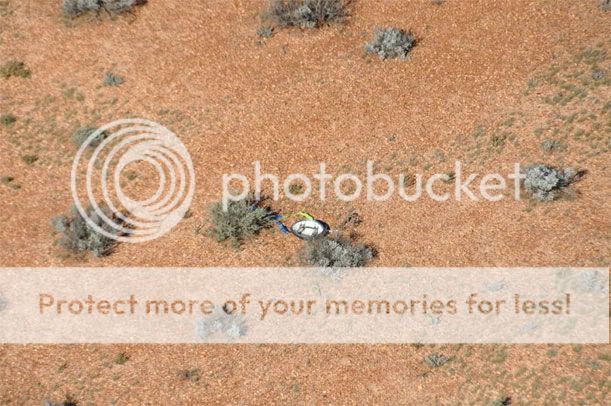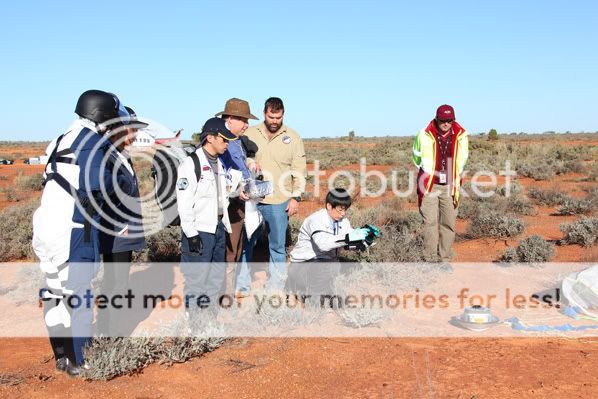R
Hayabusa Mission Topic
Page 4 - Seeking answers about space? Join the Space community: the premier source of space exploration, innovation, and astronomy news, chronicling (and celebrating) humanity's ongoing expansion across the final frontier.
You are using an out of date browser. It may not display this or other websites correctly.
You should upgrade or use an alternative browser.
You should upgrade or use an alternative browser.
- Status
- Not open for further replies.
A
andrew_t1000
Guest
Congratulations JAXA!
I just wish I could have gone "north" to add to these images!
Damn turkeys!
I just wish I could have gone "north" to add to these images!
Damn turkeys!
E
EarthlingX
Guest
www.jaxa.jp : Result of Search for the Heat Shield by Helicopter
Mission home page
http://www.jaxa.jp/projects/sat/muses_c/index_e.html
June 14, 2010 (JST)
Japan Aerospace Exploration Agency (JAXA)
Following the discovery of HAYABUSA capsule, JAXA searched for the heat shield of the capsule by a helicopter, but has not found it so far.
JAXA will restart searching the heat shield this morning.
*WPA: Woomera Prohibited Area
Mission home page
http://www.jaxa.jp/projects/sat/muses_c/index_e.html
June 14, 2010 Updated
Welcome back HAYABUSA to Earth after overcoming various difficulties!

(Image: Earth image taken by Hayabusa)
The Asteroid Explorer "HAYABUSA" successfully separated its capsule at 7:51 p.m. on June 13 (Japan Standard Time, the following times and dates are all JST,) and re-entered the atmosphere to complete its mission operation at 10:51 p.m.
After the landing, a helicopter searched for the capsule in the Woomera Prohibited Area, and at around 11:56 p.m. on the 13th, its location was confirmed.
For about seven years since its launch by an M-V Launch Vehicle in May 2003, the HAYABUSA successfully completed a great achievement by landing on the asteroid "ITOKAWA," gathering rocks there, and returning to the Earth with them while overcoming various troubles.
3
3488
Guest
Great video of Hayabusa atmospheric entry, in Japanese though, but still stunning footage.
[youtube]http://www.youtube.com/watch?v=_IAX9Hsloq4[/youtube]
Andrew Brown.
[youtube]http://www.youtube.com/watch?v=_IAX9Hsloq4[/youtube]
Andrew Brown.
E
EarthlingX
Guest
Very nice 
It's a different angle, and i think it's easier to see mothership and capsule getting separated.
It's a different angle, and i think it's easier to see mothership and capsule getting separated.
M
MeteorWayne
Guest
3488":31usdjhi said:Great video of Hayabusa atmospheric entry, in Japanese though, but still stunning footage.
Andrew Brown.
Wow, that's a great view. Also shows the plasma trail from the reentry capsule which I haven't seen in any others so far.!
T
the_harper
Guest
M
mithridates
Guest
This gives me an idea. Considering how many asteroids WISE has discovered (12,000+ new asteroids so far), shouldn't it be fairly easy to find three or so good candidates for a mission involving a number of cheap probes launched at one time that carry out a simple flyby and then return to Earth? Each one would be constructed of a somewhat different material and all they would have to do is fly by and observe the asteroid they've been assigned to, and then make their way back and burn up.
E
EarthlingX
Guest
We were discussing variations on the theme in a couple of threads, but can't exactly remember where .. I think it was when discussing Jupiter probes, or Mars, or was it in SB&T ? I'll chew on this for a bit and let you know, if no one else will. MeteorWayne might remember or 3488 ?mithridates":1x1llejd said:This gives me an idea. Considering how many asteroids WISE has discovered (12,000+ new asteroids so far), shouldn't it be fairly easy to find three or so good candidates for a mission involving a number of cheap probes launched at one time that carry out a simple flyby and then return to Earth? Each one would be constructed of a somewhat different material and all they would have to do is fly by and observe the asteroid they've been assigned to, and then make their way back and burn up.
Anyways, check this close up :
[youtube]http://www.youtube.com/watch?v=48eclsiwf6U[/youtube]
and i think we saw this before :
[youtube]http://www.youtube.com/watch?v=tmQsaNRUagA[/youtube]
E
EarthlingX
Guest
www.jaxa.jp : Retrieving the Capsule completed
June 14, 2010 (JST)
Japan Aerospace Exploration Agency (JAXA)
The Japan Aerospace Exploration Agency (JAXA) has completed the retrieval of the Hayabusa capsule at 4:08 p.m. on June 14th, 2010 (JST).
The capsule is deemed intact at the moment.
E
EarthlingX
Guest
This is HD version of the above posted close-up :
[youtube]http://www.youtube.com/watch?v=gfYA4f-AIL0[/youtube]
[youtube]http://www.youtube.com/watch?v=gfYA4f-AIL0[/youtube]
N
nimbus
Guest
3
3488
Guest
Hayabusa return capsule & parachute post landing from the JAXA helicopter.
The scene is lit by a searchight on board the chopper, as it was the dead of night in the Australian outback at Woomera.

Hayabusa Heatshield found & also photographed.
Forward part.

Backshell.

Andrew Brown.
The scene is lit by a searchight on board the chopper, as it was the dead of night in the Australian outback at Woomera.

Hayabusa Heatshield found & also photographed.
Forward part.

Backshell.

Andrew Brown.
3
3488
Guest
Hayabusa return capsule being retrieved.



Capsule is on it's way to Tokyo, Japan. As soon as tomorrow or Wednesday, when it is opened in a clean room laboratory, we will know whether or not there are samples of Asteroid 25143 Itokawa inside.
Andrew Brown.



Capsule is on it's way to Tokyo, Japan. As soon as tomorrow or Wednesday, when it is opened in a clean room laboratory, we will know whether or not there are samples of Asteroid 25143 Itokawa inside.
Andrew Brown.
N
nimbus
Guest
Not arguing its properness, but out of curiosity - What specific contingencies are the armored bomb squad getups meant for?
O
orionrider
Guest
E
EarthlingX
Guest
Good thinking. It's probably just most practical preparation for the 'what if' scenarios, but i wouldn't mind knowing more about it, like what sort of contingency was that meant for.orionrider":1vipxvie said:Disarming pyro bolts probably :?:
In the mean time, one more Itokawa, with an interesting last image - size comparison between Itokawa and ISS :
[youtube]http://www.youtube.com/watch?v=rrndmU-2x-8[/youtube]
N
nimbus
Guest
It would really be cool to see gravity at that scale in action, in motion, with that rubble loosely moving yet trapped by the asteroid's gravity field.
E
EarthlingX
Guest
http://www.jaxa.jp : JAXA President Comment on Retrieval of the HAYABUSA Capsule
June 14, 2010 (JST)
Japan Aerospace Exploration Agency (JAXA)
Asteroid Explorer "Hayabusa" was launched from Uchinoura Space Center, Kagoshima, Japan on May 9th, 2003, and touched down on the asteroid "Itokawa" in November 2005. After obtaining the asteroid's surface material, Hayabusa left for the Earth and finally, in early morning of June 13th, 2010, entered the Earth's atmosphere along with the re-entry capsule that the spacecraft detached beforehand. The capsule successfully landed in the Woomera Prohibited Area in South Australia, and was retrieved by JAXA at approximately 4:08 p.m. (JST) on June 14th, 2010.
It is a great pleasure to see Hayabusa successfully complete the 6 billion km journey, after meeting extreme difficulties that put the spacecraft on the verge of shut down numerous times. We, JAXA, would like to express our deepest gratitude to the Government of Australia, relevant people at the Woomera Prohibited Area, and NASA for their continued cooperation on the Hayabusa project. We would also like to thank the people of Japan and the world, Japanese government, and the media for their warm support and encouragement.
Retrieved capsule will be transported to JAXA Sagamihara Campus in Kanagawa, Japan. First, the sample container will be inspected, and then the content will be extracted for analysis. We hope to find the Itokawa's surface material in the capsule, and contribute to understanding the origin and evolution of the solar system.
O
orionrider
Guest
:?: This 'loose rubble pile' looks awfully solid to me.
Also it doesn't seem to have been affected by either the probe landing or the thrusters blowing. You can even make out a few recent impact craters on the regolith 'plains'.
I thought even the most gentle contact would disperse a collection of rubble and dust held together by microgravity alone... :?
Also it doesn't seem to have been affected by either the probe landing or the thrusters blowing. You can even make out a few recent impact craters on the regolith 'plains'.
I thought even the most gentle contact would disperse a collection of rubble and dust held together by microgravity alone... :?
N
nimbus
Guest
A
andrew_t1000
Guest
I love the "bomb squad" outfits!
Looks like they have seen "Andromeda Strain" too many times!
After I showed everyone here the re-enty video's, they all agreed we should have gone to Cooper Pedy to watch!
sigh...
At least I've gotten a few of the people here interested in the night sky.
Going to have a little cry now....
Looks like they have seen "Andromeda Strain" too many times!
After I showed everyone here the re-enty video's, they all agreed we should have gone to Cooper Pedy to watch!
sigh...
At least I've gotten a few of the people here interested in the night sky.
Going to have a little cry now....
B
BriK
Guest
The returned capsule is being inspected. The cylinder at the center could contain some material from Itokawa:


W
wildwell
Guest
- Status
- Not open for further replies.
TRENDING THREADS
-
Hubble Tension explained (including its value) by the two phase cosmology
- Started by Geoff Dann
- Replies: 210
-
New interpretation of QM, with new two-phase cosmology, solves 15 foundational problems in one go.
- Started by Geoff Dann
- Replies: 320
-
Basic Error: The accelerating Universe conclusion - reason
- Started by Gibsense
- Replies: 263
-
-
The birth of the Quantum Convergence Threshold (QCT):
- Started by Capanda Research
- Replies: 84
-
-

Space.com is part of Future plc, an international media group and leading digital publisher. Visit our corporate site.
© Future Publishing Limited Quay House, The Ambury, Bath BA1 1UA. All rights reserved. England and Wales company registration number 2008885.


